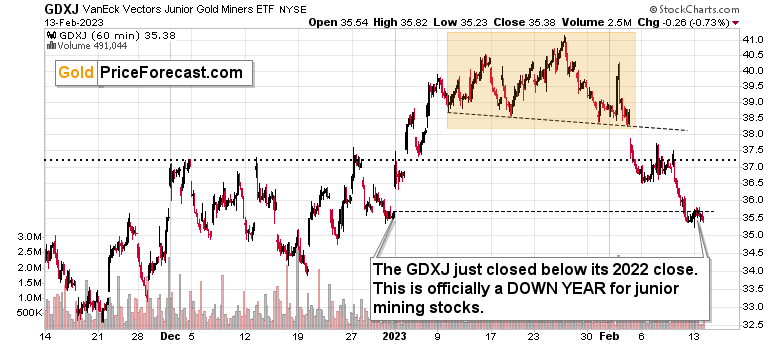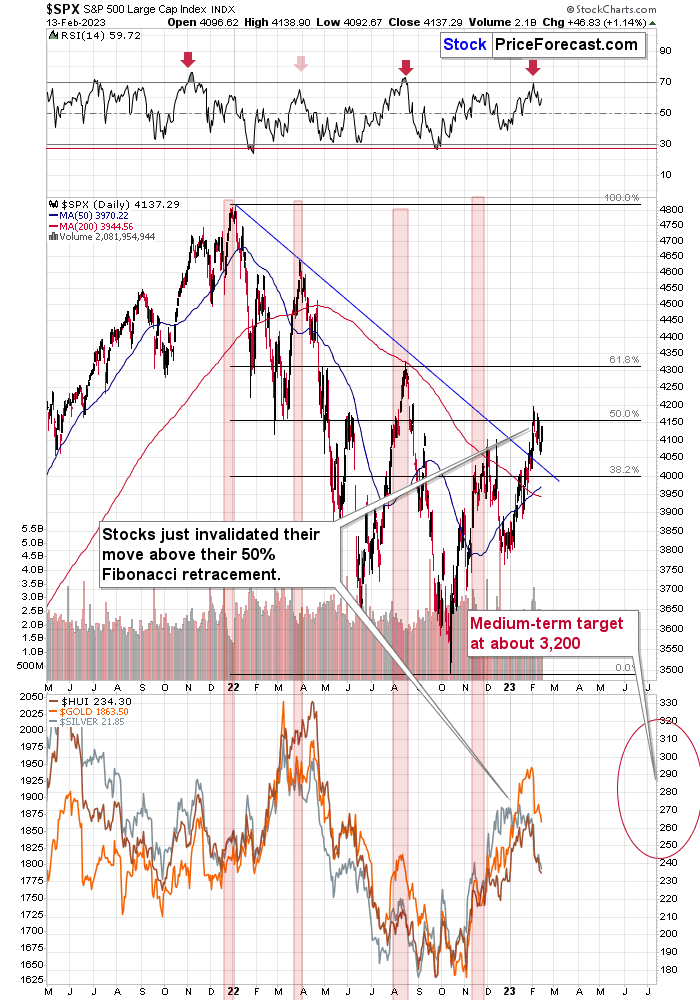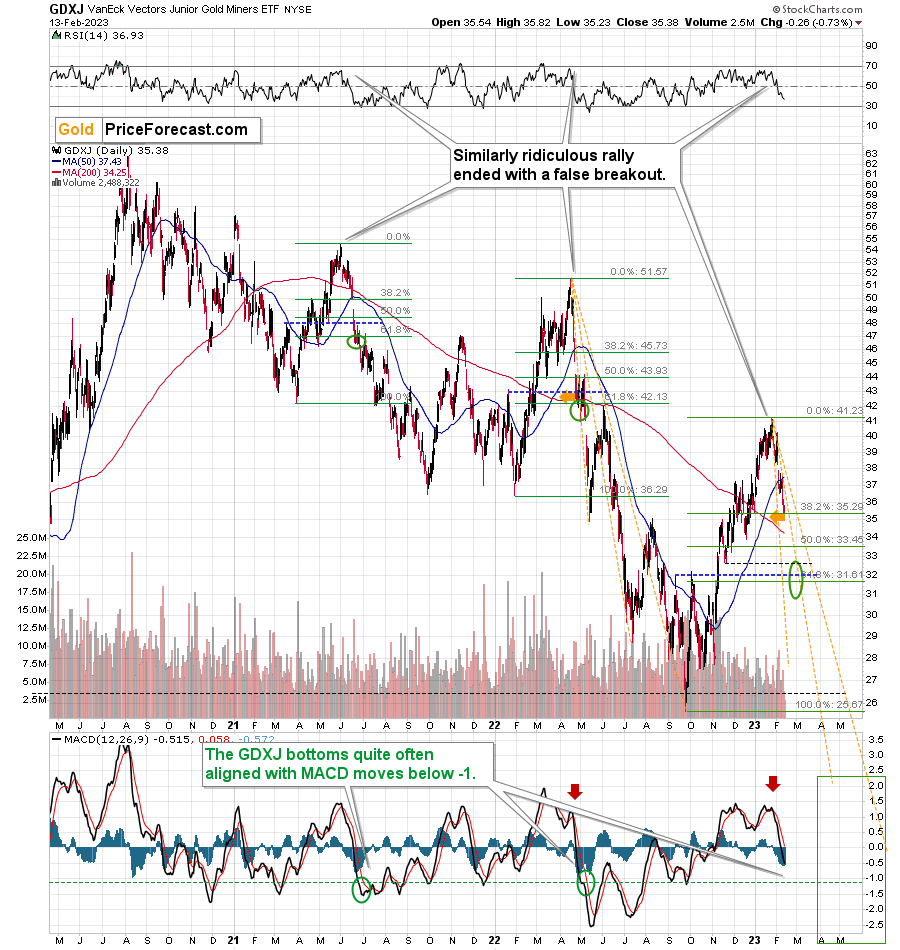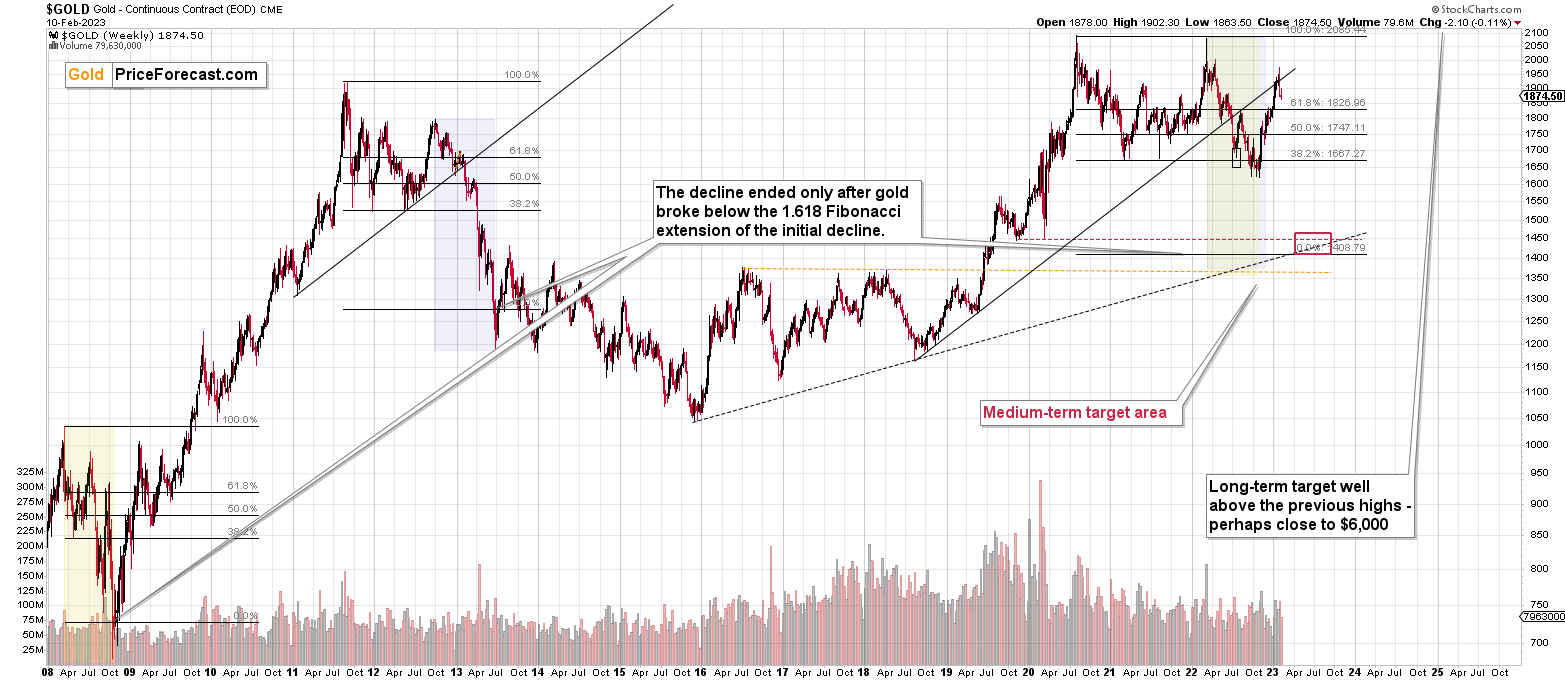Briefly: in our opinion, full (300% of the regular position size) speculative short positions in junior mining stocks are justified from the risk/reward point of view at the moment of publishing this Alert.
You know what happens on the markets after a breakdown? A test. A verification. The GDXJ had just tested this move as it had moved to new yearly lows.
What was the result?
The breakdown was a real thing, not just a blip on the radar screen.
How do I know?
Because we saw a small move back above the lowest closing prices of the previous year, after which the GDXJ ETF turned around, declined, and closed the day even lower!
What a perfect verification of the breakdown!
Another way for markets to verify their moves – besides moving briefly back to the previous support/resistance and then continuing their previous move – is their ability to stay below / above certain levels for more than one day.
Yesterday, we saw the second daily close below the 2022 close. Ideally, I want to see three consecutive daily closes before saying that a given move was confirmed, but two are important, too.
Given this verification, the short-term nature of all the bearish indications that I’ve been writing about previously got amplified.
Another intriguing aspect of yesterday's decline is that it occurred in the midst of a general stock market rally.
The S&P 500 moved higher by over 1% yesterday, so junior miners – being particularly closely related to the stock market – had a good reason to move higher and invalidated the breakdown below the 2022 close.
They didn’t. This is yet another indication pointing to junior miners’ bearish outlook.
And since mining stocks tend to lead gold… This is all bearish for gold as well.
Consequently, my yesterday’s (premium) comments on the GDXJ ETF and the near-term target area for it remain up-to-date. The same goes for the “background information” that I started yesterday’s analysis with:
This means that the entire performance of the GDXJ ETF so far this year has been one huge reversal. A rally that gold permabulls welcomed so much turned out to be something fake, just as I had warned. And since the GDXJ has been making lower lows and lower highs since its 2020 top, it’s really hard to ignore the fact that it’s been in a medium-term downtrend for quite a long time.
No breakout; no yearly rally.
It’s difficult to spot anything bullish in that picture. Sure, some people will always find a way to find something bullish in any situation – for example, gold’s recent short-term rally was quite significant. While focusing on the very near term, it’s easy to forget that gold actually failed to move above its 2011 highs (from well over a decade ago!) in nominal terms (in real terms, gold is much lower), despite so many dollars and other currencies being printed in the meantime, and despite the pandemic. And, you know… In case you forgot – there’s war in Europe!
Why isn’t the gold price above $5,000 given all those circumstances? Or at least above $3,000? Why didn't silver recover at least half of the declines from its 2011 high in nominal terms (it was much lower in real terms)? And junior mining stocks? The GDXJ is now trading for just a little more than a quarter of its value at the 2011 high. In nominal terms.
There are two primary fundamental drivers of gold prices: real interest rates and the USD Index.
The real rates are going up as the nominal rates are going higher (faster or slower, but they are still rising) and the inflation rate is declining (and so are expectations regarding it). If rates were about to overshoot inflation (as has historically been the case if the Fed wanted to fight inflation), this would imply an additional 2% increase in real interest rates. This means a powerful bearish force is about to hit the gold market. In fact, it’s already here to a large extent, and it seems that investors are no longer able to ignore it due to gold’s yet another failure to move above its 2011 high.
(…)
Speaking of junior miners, I went through the short-term chart once again, and I revisited my near-term downside target for the GDXJ.
Based on how fast the previous declines happened, and given how far the mining stocks are likely to decline, let’s keep in mind that the real risk during this downswing is to be out of the trade or – in particular – to be positioned against it (by being long) – at least, that’s the case in my opinion based on about two decades of experience in this sector.
And yes, it remains VERY LIKELY that junior miners will decline very far.
First of all, just look at the orange lines, which feature the repeat of what happened in 2022.
Second, please consider the long-term analysis of the HUI Index in Friday’s analysis.
Third, please note that real rates are going higher based on very precise historical analogies.
Fourth, please keep in mind how much worse the situation is in the eurozone (sovereign debt, e.g., in Italy…) and in Japan than in the U.S. – that’s what drives the currency exchange rates, not just the situation in the U.S. on its own – it all works on a comparative basis.
Fifth, please consider what I already wrote earlier today about junior miners’ weak performance since the 2011 top and about gold’s performance relative to its 2011 top.
So, it’s not a matter of aiming to detect all possible tiny corrective upswings, but only the bigger ones. Given the analogy to the previous corrective upswings, it seems that the GDXJ first needs to move to or a bit below its 61.8% Fibonacci retracement based on the entire recent rally.
I marked the previous cases with green Fibonacci retracements, and you can see that the above happened in both cases. Interestingly, the GDXJ also bottomed close to the recent price extreme: high or low. I marked that with blue dashed lines.
This means that the GDXJ ETF would be likely to move to about $32 before launching a corrective upswing. We would also be likely to get a confirmation from the MACD indicator, which moved below -1 before the GDXJ formed short-term bottoms. This was also a good signal in the case of the previous similar declines (which I marked with green ellipses).
When could this short-term bottom take place? As early as this month, but probably not yet this week.
That is most likely at the time of writing these words, and I will, of course, keep you updated on any changes. Whether one wants to trade the possible corrective upswing or not is a different matter, but it does indeed seem likely that we might see some correction from those levels. Please note that the decision to take advantage of the corrective upswing vs. the decision to wait it out while focusing on the big, medium-term downswing is highly individual. As is the case with pretty much everything, it’s best to keep oneself in mind: one’s risk tolerance, goals and motivations for them, time that one can dedicate to monitoring the situation, and so on.
The comments below yesterday’s Gold Trading Alert included analysis of other markets as well, so I encourage you to take a look (and maybe “thumbs up” some comments that you find valuable to express gratitude and encourage those writing them to keep it up). Some of the takeaways are:
- The GDXJ could rally to $34 or so during the correction (based on the information that we have today).
- The price of gold could bottom around $1,780 - $1,800, along with the GDXJ ETF, which is close to $32 (but it’s rather unclear at this time).
- The S&P 500’s medium-term bottom is likely to form close to 3,200, but this might not be the final bottom for the entire decline – stocks could even drop to their 2020 lows at about 2,200.
- The platinum price could also drop to its 2020 low at about $580.
Overview of the Upcoming Part of the Decline
- It seems to me that the corrective upswing is over (or about to be over) and that the next big move lower is already underway (or that it’s about to start).
- If we see a situation where miners slide in a meaningful and volatile way while silver doesn’t (it just declines moderately), I plan to – once again – switch from short positions in miners to short positions in silver. At this time, it’s too early to say at what price levels this could take place and if we get this kind of opportunity at all – perhaps with gold prices close to $1,500 - $1,550.
- I plan to switch from the short positions in junior mining stocks or silver (whichever I’ll have at that moment) to long positions in junior mining stocks when gold / mining stocks move to their 2020 lows (approximately). While I’m probably not going to write about it at this stage yet, this is when some investors might consider getting back in with their long-term investing capital (or perhaps 1/3 or 1/2 thereof).
- I plan to return to short positions in junior mining stocks after a rebound – and the rebound could take gold from about $1,450 to about $1,550, and it could take the GDXJ from about $20 to about $24. In other words, I’m currently planning to go long when GDXJ is close to $20 (which might take place when gold is close to $1,450), and I’m planning to exit this long position and re-enter the short position once we see a corrective rally to $24 in the GDXJ (which might take place when gold is close to $1,550).
- I plan to exit all remaining short positions once gold shows substantial strength relative to the USD Index while the latter is still rallying. This may be the case with gold prices close to $1,400 and GDXJ close to $15 . This moment (when gold performs very strongly against the rallying USD and miners are strong relative to gold after its substantial decline) is likely to be the best entry point for long-term investments, in my view. This can also happen with gold close to $1,400, but at the moment it’s too early to say with certainty.
- The above is based on the information available today, and it might change in the following days/weeks.
You will find my general overview of the outlook for gold on the chart below:
Please note that the above timing details are relatively broad and “for general overview only” – so that you know more or less what I think and how volatile I think the moves are likely to be – on an approximate basis. These time targets are not binding nor clear enough for me to think that they should be used for purchasing options, warrants, or similar instruments.
Letters to the Editor
I received a few messages in our e-mail inbox, but I will copy-paste them to the comments feed below my premium articles (as a reminder, the “Gold Trading Alert” space on Golden Meadow is reserved to subscribers – it’s not accessible publicly) along with my replies.
Please post your questions in the comments feed below the articles, if they are about issues raised within the article (or in the recent issues), and if they are about other, more universal matters, I encourage you to use the Ask the Community space (I’m also part of the community, after all), so that more people can contribute to the reply and then enjoy the answer. Of course, let’s keep the target-related discussions in the Gold Trading Alerts space.
Summary
To summarize, in my view, the real interest rates are up and about to soar higher, the USD Index most likely bottomed and is likely to soar, while the precious metals topped in a spectacular manner and are now likely to slide – either shortly or soon enough. The rally in gold, silver, and miners was indeed sizable, but… it’s over.
What’s next? Something exciting (and, in my view, very lucrative) or something scary – depending on how positioned and informed one chooses to be.
Also, please note that (paraphrasing Sun Tzu) “understanding the enemy without understanding your true self is only half of a victory.” Before applying any insights into actionable practice (and placing or adding to your trades), please make sure that the position that you’re about to enter and its size are aligned with your approach, your investment goals, and your risk tolerance.
In other words, I suggest starting with yourself, and tailoring the trade to you, not the other way around. Please consider your motivation for this trade and how it aligns with the rest of your approach and life in general.
Hint: don’t go for the easy answer like “money” or “profits,” but consider why the result of the trade is important – is this a part of your well-designed strategy and “you have it,” or is it something you “must absolutely do” – in other words, “it has you”…)
This will save you lots of stress, which is not only end in and of itself (your happiness and health are both closely linked to your stress levels), but it also helps you become a more profitable investor as less stress (or none thereof) means more objectivity and less risk of “running for the hills” right before a given trade becomes profitable (perhaps extremely so).
Given the above, gold’s invalidation of the temporary move above its very long-term resistance (the 2011 high!), and the situation in the USD Index, it seems that the next big move lower in the precious metals sector is already underway.
Now, as more investors realize that interest rates will have to rise sooner than expected, the prices of precious metals and mining stocks (as well as other stocks) are likely to fall. In my opinion, the current trading position is going to become profitable in the following weeks, and quite possibly in the following days. While I can’t promise any kind of performance, I fully expect it to become very profitable before it’s over and to prolong our 2022 winning streak.
After the final sell-off (that takes gold to about $1,350-$1,500), I expect the precious metals to rally significantly. The final part of the decline might take as little as 1-5 weeks, so it's important to stay alert to any changes.
As always, we'll keep you – our subscribers – informed.
To summarize:
Trading capital (supplementary part of the portfolio; our opinion): Full speculative short positions (300% of the full position) in junior mining stocks are justified from the risk to reward point of view with the following binding exit profit-take price levels:
Mining stocks (price levels for the GDXJ ETF): binding profit-take exit price: $20.32; stop-loss: none (the volatility is too big to justify a stop-loss order in case of this particular trade)
Alternatively, if one seeks leverage, we’re providing the binding profit-take levels for the JDST (2x leveraged). The binding profit-take level for the JDST: $22.87; stop-loss for the JDST: none (the volatility is too big to justify a SL order in case of this particular trade).
For-your-information targets (our opinion; we continue to think that mining stocks are the preferred way of taking advantage of the upcoming price move, but if for whatever reason one wants / has to use silver or gold for this trade, we are providing the details anyway.):
Silver futures downside profit-take exit price: $14.32
SLV profit-take exit price: $13.42
ZSL profit-take exit price: $48.87
Gold futures downside profit-take exit price: $1,504
HGD.TO – alternative (Canadian) 2x inverse leveraged gold stocks ETF – the upside profit-take exit price: $16.47
HZD.TO – alternative (Canadian) 2x inverse leveraged silver ETF – the upside profit-take exit price: $36.87
Long-term capital (core part of the portfolio; our opinion): No positions (in other words: cash)
Insurance capital (core part of the portfolio; our opinion): Full position
Whether you’ve already subscribed or not, we encourage you to find out how to make the most of our alerts and read our replies to the most common alert-and-gold-trading-related-questions.
Please note that we describe the situation for the day that the alert is posted in the trading section. In other words, if we are writing about a speculative position, it means that it is up-to-date on the day it was posted. We are also featuring the initial target prices to decide whether keeping a position on a given day is in tune with your approach (some moves are too small for medium-term traders, and some might appear too big for day-traders).
Additionally, you might want to read why our stop-loss orders are usually relatively far from the current price.
Please note that a full position doesn't mean using all of the capital for a given trade. You will find details on our thoughts on gold portfolio structuring in the Key Insights section on our website.
As a reminder - "initial target price" means exactly that - an "initial" one. It's not a price level at which we suggest closing positions. If this becomes the case (as it did in the previous trade), we will refer to these levels as levels of exit orders (exactly as we've done previously). Stop-loss levels, however, are naturally not "initial", but something that, in our opinion, might be entered as an order.
Since it is impossible to synchronize target prices and stop-loss levels for all the ETFs and ETNs with the main markets that we provide these levels for (gold, silver and mining stocks - the GDX ETF), the stop-loss levels and target prices for other ETNs and ETF (among other: UGL, GLL, AGQ, ZSL, NUGT, DUST, JNUG, JDST) are provided as supplementary, and not as "final". This means that if a stop-loss or a target level is reached for any of the "additional instruments" (GLL for instance), but not for the "main instrument" (gold in this case), we will view positions in both gold and GLL as still open and the stop-loss for GLL would have to be moved lower. On the other hand, if gold moves to a stop-loss level but GLL doesn't, then we will view both positions (in gold and GLL) as closed. In other words, since it's not possible to be 100% certain that each related instrument moves to a given level when the underlying instrument does, we can't provide levels that would be binding. The levels that we do provide are our best estimate of the levels that will correspond to the levels in the underlying assets, but it will be the underlying assets that one will need to focus on regarding the signs pointing to closing a given position or keeping it open. We might adjust the levels in the "additional instruments" without adjusting the levels in the "main instruments", which will simply mean that we have improved our estimation of these levels, not that we changed our outlook on the markets. We are already working on a tool that would update these levels daily for the most popular ETFs, ETNs and individual mining stocks.
Our preferred ways to invest in and to trade gold along with the reasoning can be found in the how to buy gold section. Furthermore, our preferred ETFs and ETNs can be found in our Gold & Silver ETF Ranking.
As a reminder, Gold & Silver Trading Alerts are posted before or on each trading day (we usually post them before the opening bell, but we don't promise doing that each day). If there's anything urgent, we will send you an additional small alert before posting the main one.
Thank you.
Przemyslaw K. Radomski, CFA
Founder, Editor-in-chief







